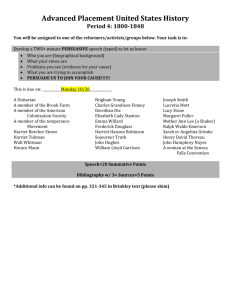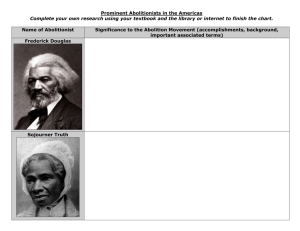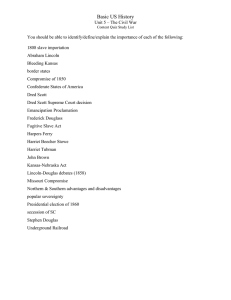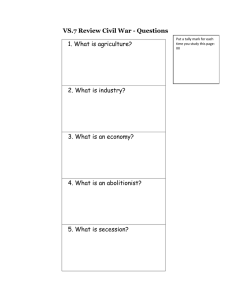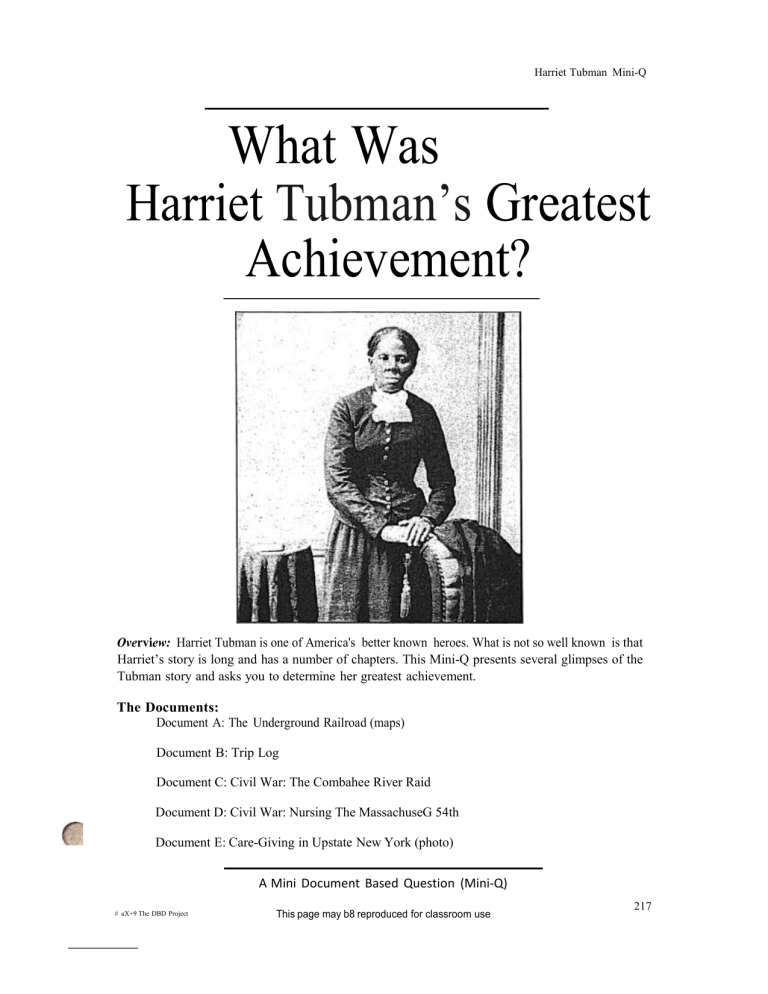
Harriet Tubman Mini-Q What Was Harriet Tubman’s Greatest Achievement? Overview: Harriet Tubman is one of America's better known heroes. What is not so well known is that Harriet’s story is long and has a number of chapters. This Mini-Q presents several glimpses of the Tubman story and asks you to determine her greatest achievement. The Documents: Document A: The Underground Railroad (maps) Document B: Trip Log Document C: Civil War: The Combahee River Raid Document D: Civil War: Nursing The MassachuseG 54th Document E: Care-Giving in Upstate New York (photo) A Mini Document Based Question (Mini-Q) # aX+9 The DBD Project This page may b8 reproduced for classroom use 217 Background Essay Harriet Tubman Mini-Q What Was Harriet Tubman’s Greatest Achievement? The place was Dorchester County, Maryland. The year was 1822, or thereabout. The event, little Araminta Ross was born into slavery. From the beginning it was clear she was tough. At five years of age, Minty Ross was hired out to do child-care. By the age of twelve she was doing field work and hauling logs. In Minty’s own words, “I grew up like a neglected weed.” Despite a loving mother, these were hard years. Like so many slaves, Araminta lived with the fear fat she would be separated from herfamily. After the Atlantic slave trade ended in 1808, great pressure was put on Maryland’s Eastern Shore to provide slaves for the cotton fields in the deep South. I-historians estimate that at this time 10% of young slaves in the upper South were sold away from their families. We know that at least two of Minty’s sisters met this fate. In 1844, Minty married a free black man named John Tubman. This did not alter Minty’s slave status but it did lead to a name change. Taking her mother’s first name, and her husband’s last Minty Ross became Harriet Tubman. When her master died in 1849, Harriet made a life-changing decision. “I had reasoned this out in my mind; there was one of two things I had a right to, liberty or death; if I could not have one, I would have the other.” Harriet decided to run. It was about one hundred miles from Harriet’s slave home near Bucktown, Maryland, to the Pennsylvania border, and another twenty miles to Philadelphia Unable to persuade her husband to join her, Harriet took off on her own. B 2Qi9 The DBQ Project She never disclosed the details of her escape. We know that it was mostly on foot, mostly traveling at night, mostly sticking to northsouthstreams and the woods. It is remarkable that she made it. Over the next eleven years Harriet would return to the Eastern Shore and Virginia at least eight times to escort other fugitive slaves to freedom. Complicating her task was the Fugitive Slave Act, known in the North as the Bloodhound Act. This act passed by Congress in 1850 required Northerners to turn in escaped slaves. Harriet now faced danger North and South. In her trips to rescue slaves and transport them to Canada, Harriet did not work alone. She was part of a secret network known as the Underground Railroad. The “railroad” had no rails and except for the occasional hidden basement, it had no underground. Rather it was a series of safe houses strung out along routes that extended from &e slave border states to Canada. The safe houses were owned by people, white and black, who hated slavery and hated the Fugitive Slave Act. This Mini-Q includes document on Harriet’s work with Ae Underground Railroad. But Harriet Tubman’s life, which sketched over ninety years, was larger than this. Examine all the documents. Consider the importance of each undertaking, the number of people helped, the risks involved, the time devoted. Then decide on your answer to the question, T7inf eras Harriet Tubman’s greatest achievement? This page may be reproduced for classroom use 221 EV Harriet Tubman Mini-Q Background Essay Questions 1. In what border state was Harriet Tubman born? Harriet Tubman was born in the eastern shore of Maryland. 2. How did the expansion of cotton fields in the deep South affect young slaves on the Eastern Shore? The Eastern Shore was pressured to provide slaves for the cotton field. 10% of the young slaves were sold away from their families for this purpose. 3. How old was Harriet when she escaped slavery? Harriet was around 27-28 years old when she escaped slavery. 4. Why did the Underground Railroad not stop in the United States but run all the way to Canada? The Underground Railroad did not stop in the US so that the slaves could escape all the way to Canada which seemed to be the safest place for them. 5. Define or explain each of these terms: Eastern Shore Fugitive Slave Act Bloodhound Act Underground Railroad 1822 — Possible birth date of Minty Ross 1844 — Minty Ross marries John Tubman; changes name to Harriet Tubman 1850 — Harriet conducts first trip on Underground Railroad 1859 — First college baseball game 1860 Tubman conduct last trip on Underground Railroad Harriet Tubman Mini-Q 1863 Combahee River raid 1890s — Tubman active in women’s suffrage movement 1908 — Harriet Tubman Home for Ae poor dedicated in New York 1913 — Harriet Tubman dies in Auburn, New York This page may be reproduced for classroom use 22 Harriet Tubman Mini-Q Document A Source: Kate Clifford Larson, Bound lor the Promised Land Ballantine Books, New York, 2004. Document Analysis 1. Including place names, directions and distances, describe a route Harriet Tubman was likely to have followed from her slave home near Bucktown to Philadelphia. 2. Traveling by foot, about how many miles was it from Bucktown to Philadelphia? From Philadelphia to St Catherine’s in Canada? It was about 120 miles from Bucktown to Philadelphia and roughly 300 miles from Philadelphia to St Catherine’s in Canada. 3. In the 1850s, why did Harriet feel compelled to escort her escaped slaves all the way to St. Catherine’s? Why, for example, didn't she stop in Albany? Harriet had to escort her slaves all the way to Canada because the Fugitive Slave Act allowed the fugitives to be captured and enslaved in the North. 4. In terms of risk or number of people helped, does this document provide evidence of a great achievement? Explain. Harriet Tubman Mini-Q This document does provide evidence of a great achievement because it takes a lot of bravery in order to risk your own life to save others which Harriet Tubman did 8 times and although it may not sound a lot, she managed to save 38 people in those 8 trips. This page may be reproduced for classroom use 22 Harriet Tubman Mini-Q Document B Source: Adapted lrom Catherine Clinton, Harriet Tubman: Tha Road to Freedom, Little, Brown and Company, New York, 2004. Note: Records of Harriet Tubman's rescue missions ar8 Very incomplete. Trip estimates range ffom 8 to 19. She made most of her trips in and around December when the nights were long and fewer people were out. Typically, Harriet did not venture onto plantations but met fugitives at a prearranged placa. When possible, "abductions” began on Saturday nights since slaves generally had a rest day Sundays and would not b0 fTlissed until Monday morning. Harriet Tubman’s Rescue Missions Date Pick Up Point End Point Cargo Dec. 1850 Near Baltimore, Md. Philadelphia (?) Niece Kizzy and 2 children Spring 1851 Dorchester Co., Md. Philadelphia (?) One brother plus two men (?) Fall 1851 Dorchester Co., Md. Canada West (Ontario) 11 fugitives including brother Fall 1852 Probable trip Probable trip Numbers Unknown Fall 1853 Maryland Niagara Falls area 9 fugitives Dec. 1854 Caroline Co., Md. St Catherine’s, Can. 3 of Harriet’s brothers Summer 1857 Dorchester Co., Md. St. Catherine’s, Can. Harriet’s mother and father* Dec. 1860 Dorchester Co., Md St Catherine’s, Can. 7 fugitives (HT’s last rescue) ** “Parents were in danger because of sheltering fugitive slaves. ”Most famous escape with drugged babies to prevent crying. Document Analysis 1. If Harriet was born in 1822, how old was she when she made her first and last rescue? Harriet was around 28 during her first rescue and about 38 on her last. 2. In what county and state did Harriet collect most of her slave fugitives? Harriet collected most of her slave fugitives in the state of Maryland, United States. 3. According to this log, what is the total number of slaves Harriet escorted to freedom? to this log, Harriet escorted approximately 38 slaves to freedom. 4. According to the Document Note, what measures did Tubman take to avoid capture? Harriet made most of her trips in December because the nights were long and fewer people would be out. She would also meet fugitives only in prearranged places. 5. In terms of risk, number of people helped, or length of time spent, does this document provide evidence of great achievement? Explain. Harriet Tubman Mini-Q g z009 The DBD Projml This page may be reproduced for classroom use 229 Harriet Tubman Mini-Q Harriet Tubman Mini-Q Document C Source: Emma Paddock Telford, interview with Harriet Tubman circa 1905. In Jean M. Humez, Harriet Tubman, The Life and the Lite Stories, University of Wisconsin Press, 2003. Note: About one year into the Civil War, Harriet Tubman was asked by th0 governor of Massachusetts to join Union troops In South Carolina. There she headed up a team of eight black spies to operate behind the Iin0s and provide intelligence lor a Union raid to free slaves. The raid was condumed on June 2, 1863. It involved three gunboats, and black troops led by a white officer, Colonel James Montgomery. When we went up the river in the morning, Well, they wasn’t my people any more it was just about light, the fog was rising over than they was his — only we was all Negroes. ... the rice fields and the people was just done They didn’t know anything about me and I their breakfast and was going out to the field. didn’t know what to say. I look at them about O minutes, and then I sung to them.... I was in the forward boat.... (T)he Colonel blowed the whistle and stopped the boat and Come from the East, Come from the West . .. a company of soldiers went ashore. About a Mong all the glorious nations, quaner of an hour after ... you could look This glorious one’s the best.... oxer the rice fields, and see them (slaves) Then they throwed up their hands and coming to the boat from every direction. 1 began to rejoice and shout Glory! And the never see such a sight.. .. Some had bags on rowboats would push off. their back with pigs in them; some had chickens I kept on singing until we brought all tied by the legs, and so child squalling, aboard. We got 800 people that day, and we chickens squawking, and pigs squeeling they tore up the railroad and fired the bridge, and all came running to the gunboats.... we went up to a big house and catched two ... When they got to the shore, they’d get pigs and named the white pig Beauregard and in the rowboat, and they’d start for the gunthe black pig Jeff Davis. boat; but the others would run and hold on so When we got back to Hilton Head in the they couldn’t leave the shore.... They was morning ..., I took 100 of the men to the afraid the gunboats (would ) go off and leave recruiting office and they enlisted in the army. them. At last the Captain looked at them and Colonel Whittle said I ought to be paid for he called me. .... “Moses, come here and speak every soldier as much as a recruiting officer. a word of consolation to your people!” But laws! I never done got nothing.” Document Analysis 1. When and in what state was the Combahee River raid? The Combahee River raid took place on June 1-2, 1863 in South Carolina. 2. What role did Harriet play in the raid? Harriet was asked to join the Union troops and there, she lead a team of eight black spies to operate behind the lin0s and provide intelligence for a Union raid to free slaves. Colonel Montgomery called Harriet “Moses.” Why? Harriet was called “Moses” because she helped people escape from slavery like Moses did. 3. Which is the greater achievement, making eight trips into slave country to free 38 slaves over a ten-year period, or leading a spy ring and helping to free 800 slaves on a single night? Both of the achievements are equally great because even though more slaves were rescued in the second achievement, Harriet knowingly put her own life at risk over half a dozen times for the slaves in the first achievement. This pag8 may be reproduced for classroom use 231 Harriet Tubman Mini-Q Document D Source: Sarah Bradford, Scenes in ffie Life of Harriet Tubman, Auburn, New York, 1869. Note: Just seven weeks after the Combahee River raid, the all-black Massachusetts 54th made their mark on history with thelr assault on Fort Wagner in Charleston Harbor. Harriet Tubman served as a nurse for the wounded survivors of the 54th Massachusetts Volunteers. The assault on Fort Wagner was the subjeM of the 1989 Academy Award-winning film “Glory.” Below is Harriet's description of her nursing experiences along with a comment from her biographer. Harriet Tubman.- “Well, Missus, I’d go the hospital, I would, every morning. I'd get a big chunk of ice . . . and put it in a basin, and fil1 it with water; then I'd take a sponge and begin. First man I’d come to, I’d thrash away the flies, and they’d rise, they would, like bees round a hive. Then I’d begin to bathe the wounds, and by the time I’d bathed off three or four, the fire and heat z'ould have melted the ice and made the water warm, and it would be as red as clear blood. Then I'd go and get more ice ... and by the time I got to the next ones, the flies would be round the first ones black and thick as ever.” Biographer Sarah Bradford: In this way (Harriet) worked, day anew day, till late at night; then she went home to her little cabin, and made about fifty pies, a great quantity of gingerbread, and two casks of root beer. These she would hire some contraband* to sell for her through the camps, and thus she would provide her support for another day; for this woman never received pay or pension, and never drew for herself but twenty days’ rations during the four years of her labors. “Contraband: An escaped staye taken in behind Union lines Document Analysis 1. When and where did Harriet do this Civil War nursing? Harriet did the civil war nursing in 1862 in Beaufort, South Carolina. 2. Who were the soldiers that Harriet nursed? The soldiers that Harriet nursed were the wounded survivors of the 54 th Massachusetts Volunteers. 3. Without army pay, how did Harriet earn money to live? Harriet earned money for herself without army pay by selling pies, gingerbread, root beer, etc. through the camps, allowing her to earn money on a day to day basis. 4. How well were Harriet Tubman’s nursing efforts recognized by the Union army? Evidence? Harriet’s efforts as a nurse went unrecognized by the Union Army which is evident because she never received any pay or pension for all that she did. 5. Which is the more important achievement — conducting slaves to freedom on the Underground Railroad, scouting a raid to free slaves behind enemy lines, or nursing wounded battle heroes? All three achievements are equally important as Harriet put in the same amount of effort in all three of the achievments. 233 This page may be reproduced for classroom use -- - - - - Harriet Tubman Mini-@ Mini-Q Harriet Tubman Document E Sourco: Schomburg Center for Research in Black Culture. Note: During the 48 years between the end ol the Civil War and her death in 1913, much of Harriet Tubman’s time was spent taking care ol poor people in her home. Harriet often had six to eight people in her care. the aged, ... Ihe babe deserted, the epileptic, the blind, the paralyzed, ... all lound shelter and welcome." Emma Telford Memoir, 1911. A group portrait (circa 1885) of Tubman (far left), her second husband, Nelson Davis (seated, hat) and residents of her private home in Auburn, New York Document Analysis 1. After the Civil War, what was the focus of Harriet Tubman’s life? 2. Who did Harriet care for? For about how many years did she do this? 3. In terms of value to society and to her country, how does Tubman’s caregiver work in Auburn compare with her other achievements? 235 This page may be reproduced for classroom use
